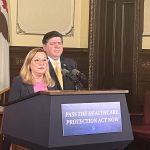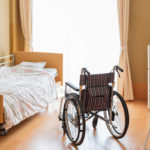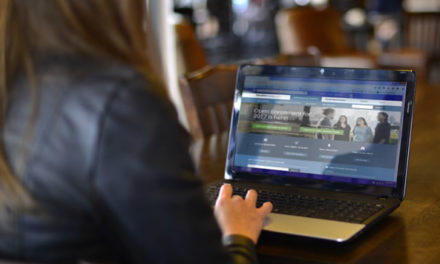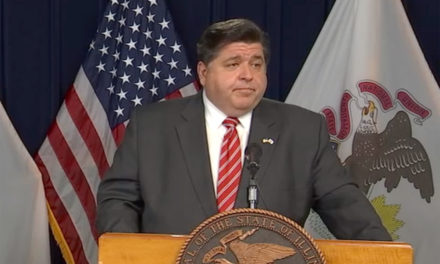
On the record with Dr. Emily Landon, executive medical director of infection prevention and control at the University of Chicago Medicine

Dr. Emily Landon, executive medical director of infection prevention and control at the University of Chicago Medicine, has become a trusted voice on COVID-19 in recent months, appearing at press conferences with Gov. JB Pritzker and providing perspective in a number of national articles.
Landon recently spoke with Health News Illinois about Illinois’ response to the pandemic, what needs to happen for youth contact sports to resume and ways to cope with the virus headed into the fall.
Edited excerpts are below.
HNI: What are some of the main lessons we’ve learned six months into the pandemic?
EL: At the beginning of the pandemic, going all the way back to when there were infections in China and it was a developing disease, we didn’t necessarily know all there was to know. We made a lot of assumptions based on how SARS behaves, how other coronaviruses behave. And since then we’ve gained a lot of experience with this virus and have a much better understanding. I think some of the most important things we learned about the virus itself are we know a lot more about how transmission works. But we don’t know everything yet. There’s obviously more to learn and I would say that our understanding of how transmissible it is, whether or not there were aerosols produced in regular everyday activities and what kind of protections are needed for healthcare workers.
I think we’ve gotten a lot more information about when we need to use better respiratory protection and when we don’t need as much respiratory protection. And I think that we’ve also learned a lot about how to provide respiratory protection to the rest of the community. So from an everyday person prevention standpoint, not just taking care of sick patients, but how to operate in the world, we now understand that fabric masks provide a lot more benefit than we thought that they did. There was very little evidence about fabric early on or from previous outbreaks, and we didn’t think that fabric masks really provided any real benefit. I think what really drove the no-mask recommendations back in March was because we didn’t have enough medical masks even for our healthcare providers. And we certainly didn’t think that fabric masks provided enough benefits. But with more study and more understanding, we now realize that fabric masks when worn by everyone do a wonderful job at trapping the droplets that people make, and really decreasing the amount of respiratory viruses in the air. And that has gone a long way. As you can see, there’s a lot of evidence now that when fabric face coverings are mandated in an area, the case counts have come down. And then we see case counts come up again when activities that require you to remove your face masks, especially indoors such as dining and bars, are opened again. So I think we learned a lot about transmission and about the role of masking and what kind of masking we need.
We still don’t know everything that there is to know about the effect of ventilation and density in indoor spaces. I think there’s a lot that we’ll learn as the weather changes and things get cooler. I think we learned a lot more about who’s at higher risk of COVID and complications. And we have started to learn a lot more about the long-term consequences of having COVID infections, and there’s a lot more to learn there itself.
And I think we’ve also learned a lot about ourselves as human beings and how we respond in a pandemic. We’ve learned that countries that did a better job of having a coherent, sort of rational approach did better than places where things were kind of piecemeal or patchwork. I think we’ve learned better how to operate in our daily life and what things we have to change in order to be able to continue doing some of the things that are part of our daily lives in order to operate in the middle of pandemic. I also think that we’ve learned a lot about testing and the world of testing, and there’s still a lot more to be learned from that, there’s a lot of questions there. I think we learned that we didn’t have enough testing in the beginning, that we underestimated the importance of asymptomatic and presymptomatic transmission. I think we paid dearly for that and I think we are continuing to learn and innovate in the area of testing and how to make testing easier and simpler, but still also effective and interpretable.
HNI: Why do you think Illinois has been able to avoid some of the worse outbreaks and rise in cases recently seen in other Midwestern states?
EL: I think that Illinois has been ahead of the curve every step of the way. And I think it’s especially hard to be ahead of the curve with the national climate as it is. I’m impressed with how Illinois has done. I’ve been impressed with the governor’s responses. I’m not connected with him in any way other than him asking me for advice and help and me providing it and him really taking time to listen and understand not just what I say, but what the scientific community as a whole says. And he’s really taken time to try and understand not just what we are recommending, but also what’s needed from the standpoint of businesses and the economy and trying to balance those things pretty well. I think Chicago has also been really aggressive, but I think that the governor is unafraid to take steps that are unpopular in order to make things better for Illinois. So I think we’ve seen the benefit of that, I think that we are holding our own. For example, I think if we had been two or three weeks later in doing a stay-at-home order in March, we would have ended up exactly like New York did.
I think we had a risk of being more like some of the southern states in the summer when we started to see cases rebound after the opening of indoor dining and bars. I think there are still parts of Illinois that are struggling with that, but I think the city of Chicago, the numbers are starting to come down in the last two weeks. And I think a lot of that is because of the closure of bars and that sort of thing in Chicago. And I think that more parts of the state need to do that. And I understand that there are real issues, that is a real industry and there are a lot of people that work in that industry and they’ve already suffered a lot of hardships. But I think we need to be focusing on how to support those individuals as opposed to just letting everything go. I think Illinois has been very aggressive. And it’s done as long as it can, considering the unique issues that there are in Illinois. South of Chicago is a bit of a red state down there, and Chicago is a big magnet for human beings and COVID. There’s a lot to contend with in Illinois, and I think we’ve done pretty well.
HNI: There’s been a lot of focus recently on whether youth and high school contact sports should be allowed to start again. Do you see a way in which these sports can start up again?
EL: At some point. One of the things that we’ve learned is that in order to control the virus human beings need to have fewer close contacts. And we are used to having on average probably 100 close contacts over the course of even a few days in regular, everyday life. And that number needs to go down to something like five in order to have a sustainable low infection rate. And we can change that number by wearing masks and by keeping distance. It’ll allow us to continue to do things without generating additional close contacts. And I think that sports are especially difficult in the high school age group because for some students this is really their ticket to everything and their entire identity is based on sports issues and less so than school. But I don’t think that anyone would argue that their scholastic education is the primary focus and should be the primary focus.
And certainly in order to be able to participate in a sport that has a lot of contact like football, in order to make that accessible in a community, one would need to have basically no other close contacts. Everybody in high school has their family as close contacts, and then there may be close contacts generated by their friends and their school. None of us have the ability to have that many close contacts. These professional sports organizations are in bubbles, where they literally have no contacts outside of the bubble. They have given up every other aspect of their life in order to be able to live in a bubble where they can play football or play basketball. And that’s not something that we can do with sports. Now, the best way for us to be able to go back to having sports is to have the lowest possible transmission rates in our community because that allows us to have more close contacts. And until we have a lower transmission rate in our community, we’ve got to keep our individual close contacts to a low, and that’s a bigger sacrifice for young people who have a limited amount of time to participate in these kinds of activities.
But if the rest of us were to give up some of our close contacts and cut our rate down, then it would make it more possible for students to be able to be in classrooms and be able to be on sports teams. But if we’re not willing to give up going to restaurants and bars, and if we’re not willing to give up some of the other things that we want to do, then they’re not gonna be able to play.
There’s also a lot of questions about the long-term consequences of having COVID. There is some new data coming out, and we just don’t know everything there is to know about this. There’s new data that’s been coming out recently looking at heart, lung and kidney damage in individuals after they have COVID, even healthy people that have mild cases and young people and athletes. I remain very optimistic that we’ll find over time that young people and healthy people are able to recover, especially the cardiac or heart issues and the inflammation of the heart muscle. But if it were my child – and I do have a son who’s 12, so he’s not in football yet – I absolutely think that we need to know more about that before we start letting kids participate in large stuff.
And I will tell you, my son was really excited about playing Little League this year. He loves Little League. He plays Little League in the suburbs near where his dad lives. And he was so excited when he was able to begin playing Little League again after the governor’s first statement on youth sports. But the Little League team literally refused to mandate masks and distance. They just said that they strongly encouraged that. And at the first thing, almost no kids wore masks, almost none of the coaches wore masks, none of the families wore masks. There was no real social distancing. They were sharing equipment, and we had to pull them out. And this is what’s happening all over America and in Illinois. People are underestimating the consequences for actions like simply not insisting on making sure the kids stay six feet apart on a bench. And it may not seem like a big deal, but it could be a really big deal. And to be perfectly honest, we don’t know how big of a deal it is yet. We just don’t know.
HNI: Do you think there’s a safe way to bring K-12 students back to in-person schooling? If so, what safety measures need to be in place?
EL: Absolutely. I think about three main considerations. I think about the local epidemiology, because the more transmission, the more cases there are in the local epidemiology, the more precautions and things you have to take inside the school to prevent transmission. And the less transmission there is in your community, the easier it is. The next thing I think about is the logistics, that’s the staff and basic stuff. So with the current, local epidemiology in Illinois is about 5 percent in some places, just under 5 percent in other places.
That means the classes have to be smaller than what they are. Physical space is a real consideration here. Many school systems have been cramming too many kids in the classrooms for ages, and we worry about them not getting enough time from the teacher. But now we’re seeing what’s really happening is that you can’t have all those kids in the classroom at the same time because it’s not safe to do so. And if you split them up into two classes, there aren’t enough teachers to teach them. And we don’t have enough money in the budget to hire that many teachers when they don’t exist. So teachers are not out there. The issues of staff are very, very real. We can’t continue to have school in as crowded of settings with as few teachers and a little building as we used to have and have a 5 percent positivity rate. Those two things are not compatible. So can you go to school with a 5 percent positivity rate? Absolutely, but they need to be in classes of very small groups of children so the teacher can come to them, and they have very limited contact, with the fact that every individual can’t have more than a few contacts because otherwise transmission gets out of control. And so many, many schools have looked at those two things and said, ‘Well, the transmission is too high, and I don’t have the staff base that I need to be able to meet that challenge.’
The last piece is, of course, that personal responsibility. And that means how willing people are to follow the rule. And I think you can see that falling apart. I think a good example was that school in Georgia where the girl sent the picture of a very crowded hallway with nobody in masks, and then she got suspended for saying something bad about the school. And she called it trouble, and I would agree with that. That is a lack of personal responsibility. They’re not holding people accountable for what needs to be done to protect everyone. Even if you have favorable epidemiology and you have the staff base and the stuff that you need in order to meet the challenge, you have to have people there to follow the rules. If you have a community where people just aren’t going to follow the rules, or schools where they’re not willing, like my son’s Little League team, to have a leadership structure that’s not willing to hold people accountable, then it’s not going to work.
HNI: In what ways have we failed, as a state and a country, in our response to COVID-19?
EL: I think there were a lot of failings. I think public health and medicine failed to understand the importance of asymptomatic and presymptomatic spread and underestimated the need for testing. That was the mistake that medicine made. I don’t know how much politics were involved in that decision.
There was good evidence coming out of China. We have a close partnership with a medical school in Wuhan, China. They went many times to work with two of the largest hospitals that were taking most of the COVID patients. And we were getting very clear information from our colleagues and friends there about presymptomatic spread, a decent amount of spread and the necessary respiratory protection and the need for larger-scale testing. So I was very confused as to why the CDC were being so restrictive on testing in early February, late January. I think the mistakes go back that far.
I think that we have all seen the lack of a consistent message from leadership in government across the nation and the misinformation that’s playing down, playing up. Any straying from sticking to the truth and the medical science of helping to explain the inconsistencies as opposed to just dismissing them and in some cases emphasizing and overblowing them has resulted in hundreds of thousands of deaths for our country. And a large reason why we can’t get back to doing things like playing youth sports, or eating in restaurants, is because we did not react as a whole country to this pandemic. We allowed misinformation and sort of wishful thinking to drive the response in large geographic areas, which really undermined the excellent work that was done in other geographic areas. For example, Illinois was very aggressive. There are many other states that are just basically ignoring science and doing whatever. They were basically just choosing their own adventure. Do you remember those books? The Choose Your Own Adventure books? You would sometimes just choose really badly and you’d get three pages in and then you would be dead. I think that’s what you’re looking at here. When you have a choose your own adventure, a lot of people chose the wrong adventure and there were a lot of people watching and that means that there are people arguing. There are people arguing that what Illinois was doing is a bad idea, when obviously Illinois is doing better than a lot of other states have been doing. And New York, where there was a long shutdown with a really careful return to normalcy, is doing better than what a lot of other places have done. But having loud voices saying, ‘That’s stupid. What you’re doing is stupid,’ and not just pointing out inconsistencies and trying to improve the response and trying to argue on behalf of industry, but really just shouting and spreading disinformation. It’s difficult, and it’s created more cases.
HNI: Do you think another lockdown, or shelter in place, could be necessary if cases tick back up again to certain levels?
EL: I sure hope not. I think that we’ve learned enough to understand how to avoid large-scale lockdown. In the beginning, we didn’t have enough PPE, we didn’t have enough tests and we didn’t have enough knowledge to understand what to do. That said, of course, the situation could get so out of control that that is the only way to do it. But I would hope that we would try everything else before we would try that and that we would apply any sort of lockdown to the smallest possible population. Contact tracing really is applying a lockdown or quarantine on specific individuals to contact close contacts with people who have COVID. That is the sort of most personalized, least invasive lockdown that you can possibly do. So I would say increasing our contact tracing capabilities and enforcement of that is key to avoiding larger scale lockdown.
HNI: With COVID exhaustion setting in, and colder months ahead, what’s your advice on how to best coexist with COVID?
EL: The best advice I can give is that COVID for everybody is a form of a loss. Not just those who lost loved ones and family members, but also people who have lost out on vacation, lost out on being able to play football, lost out on income from your business. Every single one of us has experienced a loss, and that means there’s grieving to be done, even when someone hasn’t died. And that grieving includes things like being angry, being in denial, bargaining, trying to make the situation better, feeling depressed. Those are all normal parts of how we should be feeling about this pandemic.
We also need to move on to acceptance, and we need to try and help ourselves get to acceptance. We all know someone who’s had a big trial or grief in their family and they can’t move on from it, and that’s where we are as a nation. We’re being encouraged by our leaders to stay in anger, denial and bargaining. And that’s not helping any of us. We need to accept the fact that COVID is part of our lives and try and find creative ways. Americans have a ton of ingenuity. We are the best country in the world in figuring out how to do this and how to do it right. But the more time that we spend arguing about not wearing our masks or when we have to wear a mask and when we don’t have to wear masks, it’s just bargaining.
There’s denying that COVID even exists, that it’s a hoax. Again that’s a denial. And being angry at people for taking action to try and prevent spread. There’s anger that your kid can’t play sports or that you can’t go to the gym or whatever the situation is. Those aren’t getting us anywhere. So normal emotions, of course, people should be allowed to express them. I agree with that.
But we’ve got to find a way as a country to move on. It will be so much easier for all of us as COVID fatigue sets in. Of course, we show our fatigue. But I’m also fatigued from all the anger. I’m fatigued from all the denial. I’m fatigued from all the bargaining and arguing about whether or not masks are needed. The science is settled. We need to wear masks, we’ve got to keep our distance, we can’t have crowds indoors, we can’t have large gatherings. It’s time now for us to move on, begin to figure out ways for us to be creative and do things that will help us get through that.









